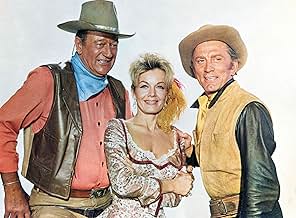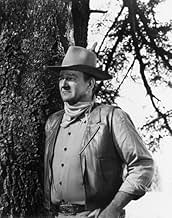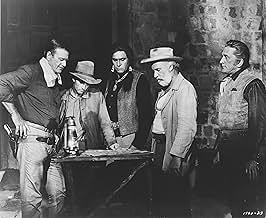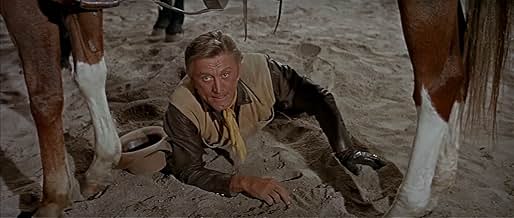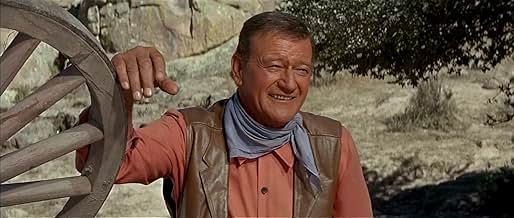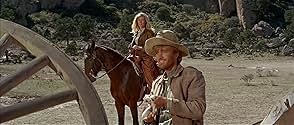ÉVALUATION IMDb
6,8/10
12 k
MA NOTE
L'histoire d'un homme qui a été abattu, volé et emprisonné, qui revient pour voler une grosse cargaison d'or à l'homme qui lui a fait du tort. L'or est transporté dans un carrosse blindé, le... Tout lireL'histoire d'un homme qui a été abattu, volé et emprisonné, qui revient pour voler une grosse cargaison d'or à l'homme qui lui a fait du tort. L'or est transporté dans un carrosse blindé, le War Wagon.L'histoire d'un homme qui a été abattu, volé et emprisonné, qui revient pour voler une grosse cargaison d'or à l'homme qui lui a fait du tort. L'or est transporté dans un carrosse blindé, le War Wagon.
- Réalisation
- Scénariste
- Vedettes
- Prix
- 1 victoire au total
Robert Walker Jr.
- Billy Hyatt
- (as Robert Walker)
Emilio Fernández
- Calita
- (as Emilio Fernandez)
Boyd 'Red' Morgan
- Early
- (as Red Morgan)
Avis en vedette
'The War Wagon' will never be considered one of John Wayne's great Westerns like 'Rio Bravo', 'The Searchers', or 'Red River', but it is a an enjoyable Western with fine performances and great rapport between Kirk Douglas and John Wayne. The action sequences are well done, the humor dry as the desert it takes place in, and the caper story line rather refreshing for a John Wayne film.
The problem? When the picture ends it leaves you feeling empty. The characters are not particularly interesting (save for Douglas) and the villain is your standard cattle baron murderous jerk. The war wagon itself is an interesting prop and well used, but never really becomes the menacing character it should've been. I enjoyed the movie as a fan of John Wayne and Westerns in general, yet I doubt most of his fans will find this film particularly impressive when compared to many of his other Westerns directed by Hawks and Ford. That isn't to say you should avoid seeing 'The War Wagon', but you should temper your expectations for what is really just an empty Saturday-afternoon adventure. You'll like it while you're watching it and then forget it as soon as the credits roll.
The problem? When the picture ends it leaves you feeling empty. The characters are not particularly interesting (save for Douglas) and the villain is your standard cattle baron murderous jerk. The war wagon itself is an interesting prop and well used, but never really becomes the menacing character it should've been. I enjoyed the movie as a fan of John Wayne and Westerns in general, yet I doubt most of his fans will find this film particularly impressive when compared to many of his other Westerns directed by Hawks and Ford. That isn't to say you should avoid seeing 'The War Wagon', but you should temper your expectations for what is really just an empty Saturday-afternoon adventure. You'll like it while you're watching it and then forget it as soon as the credits roll.
I didn't like the "War Wagon" when it was first released, I found it rather silly and vaguely offensive. The problem was me, I was not ready to recognize, let alone relate to, a subtle parody of the western genre. I should have been more receptive because in the mid-60s a huge amount of genre parody began to appear on television ("Batman", 'Wild Wild West", "F- Troop", "Get Smart"), which could be traced back to gently tongue-in-cheek series like "Maverick" and "Zorro".
"Cat Ballou" (1965) was the first feature length parody of Western genre clichés. But its parody elements were obvious, even if you were not that familiar with the conventions of the Western genre you could recognize exaggerations and revisions. In addition, up to this point John Wayne films had given the Western genre only very traditional treatments.
But "The War Wagon" was only the first example of director Burt Kennedy's tweaking of the genre. He would follow it up with "Support Your Local Sheriff" (1969), "Hannie Caulder" (1971), and "Support Your Local Gunfighter" (1971). Wayne would toy with parodic elements two years later with "True Grit", and would stay much less traditional with the remainder of his westerns.
"The War Wagon" is also a genre hybrid as western is mixed with buddy picture and big heist movie. Taw (John Wayne) recruits an old enemy Lomax (Kirk Douglas) as he seeks revenge on a ruthless mine owner (Bruce Cabot) who not only framed and sent to him prison, but appropriated his ranch and personal possessions after a huge gold strike was discovered on ranch property (here we go with the exaggeration-the only things missing are stealing Taw's wife, adopting his children, and leaving his toilet seat up). Cabot transports his gold in a "Wild Wild West" inspired armored wagon.
The interplay between Wayne and Douglas (who always seems right on the verge of accepting Cabot's standing offer of $12,000 to kill Wayne) is clever and sarcastic, working with the many exaggerated elements to provide the film's considerable humor.
"The War Wagon" finds Wayne on the wrong side of established authority, for at least the third time as his Ethan Edwards character in "The Searchers" also operated well outside the law and Quirt Evans in "Angel and the Badman" had to be bad enough that he could be reformed by Gail Russell.
Howard Keel plays the civilized Indian sidekick mostly for comic relief and the characters actually demonstrate an awareness of the movie context when they self-reflexively (deliberately drawing attention to their playing characters in a movie) refer to a tactic as an old Indian trick. Ultimately the joke (and the irony) is on Wayne and Douglas, as their seemingly one-sided deal with the Indians (a few blankets in exchange for their participation) causes the Indians to end up with most the rewards.
"The War Wagon's" understated parody style would inspire John Huston ("The Life & Times Of Judge Roy Bean") and George Roy Hill ("The Sting"); and of course many others.
Then again, what do I know? I'm only a child.
"Cat Ballou" (1965) was the first feature length parody of Western genre clichés. But its parody elements were obvious, even if you were not that familiar with the conventions of the Western genre you could recognize exaggerations and revisions. In addition, up to this point John Wayne films had given the Western genre only very traditional treatments.
But "The War Wagon" was only the first example of director Burt Kennedy's tweaking of the genre. He would follow it up with "Support Your Local Sheriff" (1969), "Hannie Caulder" (1971), and "Support Your Local Gunfighter" (1971). Wayne would toy with parodic elements two years later with "True Grit", and would stay much less traditional with the remainder of his westerns.
"The War Wagon" is also a genre hybrid as western is mixed with buddy picture and big heist movie. Taw (John Wayne) recruits an old enemy Lomax (Kirk Douglas) as he seeks revenge on a ruthless mine owner (Bruce Cabot) who not only framed and sent to him prison, but appropriated his ranch and personal possessions after a huge gold strike was discovered on ranch property (here we go with the exaggeration-the only things missing are stealing Taw's wife, adopting his children, and leaving his toilet seat up). Cabot transports his gold in a "Wild Wild West" inspired armored wagon.
The interplay between Wayne and Douglas (who always seems right on the verge of accepting Cabot's standing offer of $12,000 to kill Wayne) is clever and sarcastic, working with the many exaggerated elements to provide the film's considerable humor.
"The War Wagon" finds Wayne on the wrong side of established authority, for at least the third time as his Ethan Edwards character in "The Searchers" also operated well outside the law and Quirt Evans in "Angel and the Badman" had to be bad enough that he could be reformed by Gail Russell.
Howard Keel plays the civilized Indian sidekick mostly for comic relief and the characters actually demonstrate an awareness of the movie context when they self-reflexively (deliberately drawing attention to their playing characters in a movie) refer to a tactic as an old Indian trick. Ultimately the joke (and the irony) is on Wayne and Douglas, as their seemingly one-sided deal with the Indians (a few blankets in exchange for their participation) causes the Indians to end up with most the rewards.
"The War Wagon's" understated parody style would inspire John Huston ("The Life & Times Of Judge Roy Bean") and George Roy Hill ("The Sting"); and of course many others.
Then again, what do I know? I'm only a child.
John Wayne and Kirk Douglas appeared together in three films between 1965 and 1967. First off was "In Harm's Way" in 1965, then the ensemble picture that was "Cast a Giant Shadow" in 1966. Then came this film, their first Western, and sadly their last outing together. Sadly because The War Wagon shows a real genuine chemistry between two men who were very different socially; but on screen they clearly had regard for what each one gave to a movie. Directed by Burt Kennedy and coming out of Wayne's own Batjac Productions, The War Wagon centres around two old friends (some what grudgingly it seems) who plan to rob the vehicle of the title. An armoured stage coach, resplendent with Gatling Gun, manned front middle and centre with crack shot gunmen, and full of gold, lots of gold! Adding fuel to the fire is that the Wagon is run by a man called Frank Pierce (Bruce Cabot), who stole Taw Jackson's (Wayne) ranch as he "cough-cough" served time in jail. Further upping the intrigue is that Pierce wants to hire known gunman Lomax (Douglas) to kill Jackson, oblivious that the two men are plotting to rob him.
If that all sounds like a caper movie then you would be right, because it is, and a splendid one at that. A caper movie in a Western setting, lusciously photographed by Duke Wayne's favourite cinematographer, William H. Clothier at Durango in Mexico, and rattling along at a fair old clip. Support comes in the form of Howard Keel (a humorous turn as Indian Levi Walking Bear), Robert Walker Jr, Keenan Wynn, Valora Noland and look out for Bruce Dern in a short but effective role. We got quips aplenty as the two machismo fuelled stars play off each over with glee, we got one almighty punch up that had me personally laughing out loud and for those that like good stunt work, well we are well served there also. It's also a film to note because it sees Wayne playing a baddie, an ex convict leading an odd bunch of robbers, driven by revenge and greed. A role that by the looks of it, Wayne loved immensely. So saddle up folks, and as soon as you hear the quirky strains of Ed Ames' warbling "Ballad of The War Wagon," you should know you are in for a smashing little treat. 7/10
If that all sounds like a caper movie then you would be right, because it is, and a splendid one at that. A caper movie in a Western setting, lusciously photographed by Duke Wayne's favourite cinematographer, William H. Clothier at Durango in Mexico, and rattling along at a fair old clip. Support comes in the form of Howard Keel (a humorous turn as Indian Levi Walking Bear), Robert Walker Jr, Keenan Wynn, Valora Noland and look out for Bruce Dern in a short but effective role. We got quips aplenty as the two machismo fuelled stars play off each over with glee, we got one almighty punch up that had me personally laughing out loud and for those that like good stunt work, well we are well served there also. It's also a film to note because it sees Wayne playing a baddie, an ex convict leading an odd bunch of robbers, driven by revenge and greed. A role that by the looks of it, Wayne loved immensely. So saddle up folks, and as soon as you hear the quirky strains of Ed Ames' warbling "Ballad of The War Wagon," you should know you are in for a smashing little treat. 7/10
Take the idea of gold shipment transported by an impenetrable vehicle, armored, armed and escorted by a team of armed guards. Your goal, rob it.
Sounds like another bank job/caper flick starring Nick Cage or taking place in Vegas? Sure! But, make it an old time western, then cast John Wayne, Kirk Douglas, Bruce Cabot, Bruce Dern, Keenan Wynn and Howard Keel as a Jewish Indian and you have the makings of a classic.
The War Wagon, complete with catchy title tune, is another notch in the Duke's gun for being dead on target for what his fans crave: A solid, stoic hero, framed, robbed of all his possessions and jailed by an evil banker (Cabot), he is released and vows revenge by stealing his regular gold dust shipment. The problem is that the gold is transported in the title vehicle, an armored stagecoach with gattling gun mounted on top; an unstoppable juggernaut escorted by two teams of riflemen and riders. Throw in Kirk Douglas as an old friend who's been hired to kill him, a drunken, shaky nitro expert, played by the ever pre-pubescent looking Robert Walker Jr., a half Jewish/Half-Indian compadre (Howard Keel), a bitter, miserly thief (Keenan Wynn), his young, enslaved wife (a luminescent Joanna Barnes, also a "Spartacus" alumni)), toss in typical Western scum like Bruce Dern, and you have a high adventure caper flick that will keep you entertained for the length of the picture.
The on-screen magic of Wayne and Douglas is never in better form than here, with all the usual hijinks the stars can pack into this epitome of the Saturday Matinee Action movie before they became techo-terrors of dueling visual effects.
Sounds like another bank job/caper flick starring Nick Cage or taking place in Vegas? Sure! But, make it an old time western, then cast John Wayne, Kirk Douglas, Bruce Cabot, Bruce Dern, Keenan Wynn and Howard Keel as a Jewish Indian and you have the makings of a classic.
The War Wagon, complete with catchy title tune, is another notch in the Duke's gun for being dead on target for what his fans crave: A solid, stoic hero, framed, robbed of all his possessions and jailed by an evil banker (Cabot), he is released and vows revenge by stealing his regular gold dust shipment. The problem is that the gold is transported in the title vehicle, an armored stagecoach with gattling gun mounted on top; an unstoppable juggernaut escorted by two teams of riflemen and riders. Throw in Kirk Douglas as an old friend who's been hired to kill him, a drunken, shaky nitro expert, played by the ever pre-pubescent looking Robert Walker Jr., a half Jewish/Half-Indian compadre (Howard Keel), a bitter, miserly thief (Keenan Wynn), his young, enslaved wife (a luminescent Joanna Barnes, also a "Spartacus" alumni)), toss in typical Western scum like Bruce Dern, and you have a high adventure caper flick that will keep you entertained for the length of the picture.
The on-screen magic of Wayne and Douglas is never in better form than here, with all the usual hijinks the stars can pack into this epitome of the Saturday Matinee Action movie before they became techo-terrors of dueling visual effects.
I believe you would have to say that this is the first time John Wayne was not on the side of law and order in a movie since Three Godfathers. Between then and The War Wagon, a past that is less than savory has been hinted at, but only in The War Wagon has it been explicitly said he's an outlaw.
An outlaw with revenge on his mind. He's going rob Bruce Cabot, the slimy villain who's taken over his ranch and discovered enough gold on it to make him a rich man.
This is a caper film, maybe the only one Duke ever made. Though it might not come to mind, this film is definitely in the tradition of Topkapi and How to Steal a Million. Granted the comedy isn't exactly highbrow like the other two films, still the War Wagon is an honorable addition to that genre.
Helping Wayne along in his enterprise are Kirk Douglas a gunfighter/ safe-cracker, Howard Keel a cynical Indian, Robert Walker, Jr. a young alcoholic explosives expert and Keenan Wynn an old codger who works for Bruce Cabot and is essentially their inside man.
Kirk Douglas in his memoirs The Ragman's Son held the Duke in enormous respect even though their political views differed radically. The three films they did together show the good camaraderie they developed.
The title of the film refers to an armored vehicle with a Gatling gun that Bruce Cabot uses to ship gold. I won't say what the plan is on how the War Wagon is dealt with, but anyone who has watched the George Marshall/Glenn Ford film, Imitation General, will have some idea.
A good entertaining John Wayne western which is as good as it gets.
An outlaw with revenge on his mind. He's going rob Bruce Cabot, the slimy villain who's taken over his ranch and discovered enough gold on it to make him a rich man.
This is a caper film, maybe the only one Duke ever made. Though it might not come to mind, this film is definitely in the tradition of Topkapi and How to Steal a Million. Granted the comedy isn't exactly highbrow like the other two films, still the War Wagon is an honorable addition to that genre.
Helping Wayne along in his enterprise are Kirk Douglas a gunfighter/ safe-cracker, Howard Keel a cynical Indian, Robert Walker, Jr. a young alcoholic explosives expert and Keenan Wynn an old codger who works for Bruce Cabot and is essentially their inside man.
Kirk Douglas in his memoirs The Ragman's Son held the Duke in enormous respect even though their political views differed radically. The three films they did together show the good camaraderie they developed.
The title of the film refers to an armored vehicle with a Gatling gun that Bruce Cabot uses to ship gold. I won't say what the plan is on how the War Wagon is dealt with, but anyone who has watched the George Marshall/Glenn Ford film, Imitation General, will have some idea.
A good entertaining John Wayne western which is as good as it gets.
Le saviez-vous
- AnecdotesDuring the production, Kirk Douglas was late to the set because he was shooting a commercial endorsement for the Democratic Governor of California, Edmund G. Brown. John Wayne was furious, and was late to work the next day because he was shooting a commercial for the Republican candidate Ronald Reagan.
- GaffesWhen the gold wagon crashes it stops with it's right side wheels up. When Taw gets to it, it has it's left side wheels in the air.
- ConnexionsFeatured in The Dick Cavett Show: Kirk Douglas (1971)
Meilleurs choix
Connectez-vous pour évaluer et surveiller les recommandations personnalisées
- How long is The War Wagon?Propulsé par Alexa
Détails
Box-office
- Brut – États-Unis et Canada
- 11 990 000 $ US
- Durée
- 1h 41m(101 min)
- Couleur
- Rapport de forme
- 2.35 : 1
Contribuer à cette page
Suggérer une modification ou ajouter du contenu manquant



